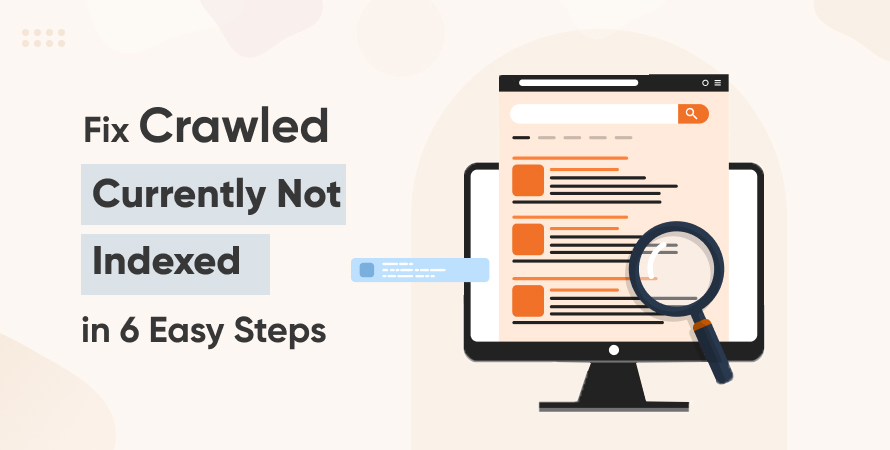Fix ‘Crawled – Currently Not Indexed’ in 6 Easy Steps



Introduction
If you’ve been monitoring your website through Google Search Console and stumbled upon the status “Crawled – Currently Not Indexed”, you’re not alone. This cryptic message often leaves site owners confused and concerned. You’ve created content, ensured it’s accessible, and yet Google chooses not to index it. Why?
Indexing is one of the most crucial steps in getting your content seen on search engines. When Google crawls a page but doesn’t index it, that page remains invisible in search results, which can significantly hinder traffic and growth.
Whether you’re a small business owner, a digital marketing agency, or a freelance SEO consultant, this guide is tailored to help you understand what this status means and how to fix it using six actionable steps. We’ll also explore what causes this problem and how you can request Google to crawl your site the right way.
Let’s dive in.
Understanding the ‘Crawled – Currently Not Indexed’ Message
The status “Crawled – Currently Not Indexed” in Google Search Console means that Googlebot has visited the page, but after evaluating it, decided not to include it in its index. This doesn’t mean the page is broken or blocked, just that Google didn’t find it valuable enough to include—at least for now.
How is it different from other statuses?
- Discovered – Currently Not Indexed: The URL is known to Google but hasn’t been crawled yet.
- Excluded by ‘noindex’ tag: The page has explicitly been told not to be indexed.
- Duplicate Without User-Selected Canonical: Google thinks the content is a duplicate and prefers another version.
In Google Search Console, the “Crawled – Currently Not Indexed” message indicates a gray area—technically accessible, but not considered worthy of inclusion in search results at this time.
Why It Happens: 8 Root Causes Behind This Status
Before rushing to request Google to recrawl your site, it’s important to understand why it happened in the first place. Here are the most common reasons:
Thin or Low-Quality Content
If your page lacks substance, Google may not find it useful enough to index.
Duplicate Content
Multiple pages covering the same topic without differentiation can cause Google to skip some.
Crawl Budget Limitations
Large sites often face restrictions on how many pages Google will crawl and index during a given period.
Lack of Backlinks
Pages with zero or very few external backlinks may seem unimportant to search engines.
Weak Internal Linking
If no other pages link to this one, Google may consider it an orphan page.
Poor User Experience
Bad mobile usability or failing Core Web Vitals metrics can influence Google’s decision.
Technical SEO Errors
Incorrect use of JavaScript, rendering issues, or incorrect meta tags can interfere with indexing.
Long Crawl Delays in Robots.txt
Overly cautious crawl-delay settings can discourage Google from revisiting pages.
Pre-Fix Checklist: What to Analyze Before Taking Action
Before applying fixes, perform a thorough diagnostic review. This ensures you’re not wasting time on guesswork.
- Search Console Coverage Report: Identify affected URLs and their current status.
- Use Screaming Frog or Sitebulb: Crawl your site and compare with what Google sees.
- Review Log Files (if available): Look at actual crawl behavior.
- Test with URL Inspection Tool: Understand how Google renders and indexes the page.
- Check for Duplicate Content: Use tools like Copyscape or Siteliner.
- Evaluate Content Quality: Does the page answer a specific query well?
Only after this assessment should you proceed with fixes.
‘Crawled – Currently Not Indexed’ Fix- 6 Easy Steps
Step 1: Audit and Improve Content Quality
Google has been vocal about prioritizing helpful, reliable, and people-first content. Ensure your content is:
- Unique and not copied from other sources
- Aligned with search intent
- Expertly written, preferably by or with input from someone with first-hand experience
- Updated regularly with accurate and trustworthy information
- Experience: Does the author have real-world experience?
- Expertise: Is the content well-researched and insightful?
- Authoritativeness: Are there references or citations to credible sources?
- Trustworthiness: Is the website secure, and is the content free from misleading claims?
If your content lacks these qualities, it’s less likely to be indexed by Google.
Step 2: Enhance Internal Linking and Site Structure
Pages that are deeply buried in your site or not linked from any other page are less likely to be crawled effectively.
- Ensure every page is linked to at least once internally
- Use keyword-rich anchor text that reflects the page’s topic
- Add high-value content to your main navigation or category pages if relevant
A better site architecture ensures faster and more frequent crawling, improving your indexing chances.
Step 3: Build Backlinks to Underindexed Pages
If your page has value but no backlinks, it may appear insignificant to Google. Building quality backlinks sends a strong signal that the page is worth indexing.
- Consider guest posting with a backlink to the affected page
- Share the content across your social media platforms
- Submit it to relevant communities and forums
Backlinks remain a powerful indicator of authority, and even a few high-quality ones can make a difference.
Step 4: Fix Technical SEO Errors and Improve Core Web Vitals
Google has confirmed that Core Web Vitals—page speed, interactivity, and visual stability—play a role in search performance. Slow or unresponsive pages may be skipped by Google.
- Use tools like PageSpeed Insights and Lighthouse to identify issues
- Fix mobile usability errors
- Ensure clean, crawlable HTML structure
- Use minimal JavaScript and avoid lazy-loading critical content
Working with a professional or digital marketing agency can help you resolve deeper technical problems faster.
Step 5: Use the Google Recrawl Request (Fetch & Index) Properly
Once you’ve implemented your fixes, it’s time to request Google to crawl your site again.
- Open Google Search Console
- Use the URL Inspection Tool
- Enter the affected URL and click “Request Indexing”
This sends a signal to Google that the page has been updated and should be reevaluated. Avoid overusing this tool—it should be reserved for genuinely improved or new content.
You can also submit updated XML sitemaps or use the Indexing API for quicker re-evaluation in certain cases.
Step 6: Strengthen Domain Signals and Crawl Budget Allocation
Improve the overall health of your site to help Google prioritize the right URLs:
- Keep your sitemap up to date and submit it regularly
- Use robots.txt wisely—don’t block critical paths
- Remove outdated or broken pages (404s)
- Consolidate thin or duplicate pages into stronger, combined content
Sites with strong domain signals—such as trust, authority, and a clean structure—naturally attract more crawls and indexing attention from Google.
Tips for Future-Proof Indexing
Use Monitoring Tools
Stay ahead of indexing issues by setting up real-time alerts with tools like Ahrefs, SEMrush, or Google Search Console. These platforms notify you when a page drops out of the index or encounters crawl errors, allowing for quick intervention.
Create a Monthly Content Audit Calendar
Schedule regular content audits to identify and address low-performing or outdated pages. Prioritize web pages that remain unindexed for extended periods and assess them for quality, relevance, and structure.
Publish Consistently
Frequent content updates signal to Google that your website is active and authoritative. Even modest updates to existing content can prompt a re-crawl and potential indexation.
Promote Your Content
Share your content across social platforms, email lists, and relevant communities. Increased visibility can lead to more backlinks and traffic signals—both of which encourage Google to revisit and index the non-indexed pages on your site.
Conclusion
The “Crawled – Currently Not Indexed” status can feel frustrating, especially after you’ve put effort into creating and publishing content. However, it also presents an opportunity—a wake-up call to improve your content quality, technical SEO, and overall site authority.
By following the six steps outlined in this guide—content optimization, internal linking, backlink acquisition, technical fixes, recrawl requests, and crawl budget management—you’re positioning your website for better indexing and visibility in search results.
If technical SEO challenges, page experience issues, or Core Web Vitals are getting in your way, it may be time to bring in expert help. Consider hiring Core Web Vitals consultants to ensure your site is optimized for both users and search engines.
Frequently Asked Questions (FAQs)
It means Googlebot has crawled your page but decided not to include it in the index—usually due to perceived low value, quality, or relevance.
It varies. If the page is of high quality and properly linked, indexing can happen within a few hours or days. If not, it may never be indexed.
Yes, poor Core Web Vitals scores can negatively impact crawling and indexing as they influence user experience, which is a factor in Google’s evaluation.
Only after making substantial updates or publishing new content. Excessive Google website crawl requests can signal spammy behavior and be ignored.
If a page hasn’t been indexed for a long time and doesn’t serve strategic value, consider consolidating or deleting it to improve crawl efficiency.